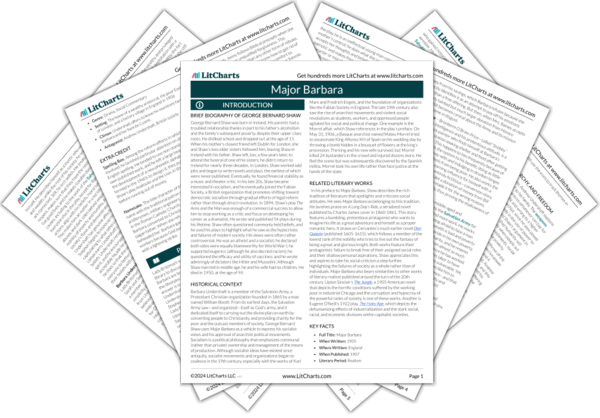Welcome to the LitCharts study guide on George Bernard Shaw's Major Barbara. Created by the original team behind SparkNotes, LitCharts are the world's best literature guides.
Major Barbara: Introduction
Major Barbara: Plot Summary
Major Barbara: Detailed Summary & Analysis
Major Barbara: Themes
Major Barbara: Quotes
Major Barbara: Characters
Major Barbara: Terms
Major Barbara: Symbols
Major Barbara: Theme Wheel
Brief Biography of George Bernard Shaw

Historical Context of Major Barbara
Other Books Related to Major Barbara
Key Facts about Major Barbara
- Full Title: Major Barbara
- When Written: 1905
- Where Written: England
- When Published: 1907
- Literary Period: Realism
- Genre: Drama, Social Commentary
- Setting: The home of a wealthy aristocrat, the poor East End of London, and a factory village in England in 1906
- Climax: Undershaft offers to leave his munitions factory to Barbara and her fiancée Cusins.
- Antagonist: Andrew Undershaft, British society
Extra Credit for Major Barbara
Spelling Bee. Among the reform efforts in which Shaw was involved, he lavished particular attention on attempts to reform English spelling. He tended to use non-standard spellings in his own published work, and he left a large bequest in his will for the development of a new phonetic alphabet. A task force formed in the 1960s to design it; they published an edition of Shaw’s play Androcles and the Lion, in Shavian script in 1962 before running out of money.
Namesake. The title character of Major Barbara shares her name with the traditional patron saint of armorers, artillerymen, military engineers, explosives experts, and miners in the Roman Catholic Church. According to her legend, Barbara converted to Christianity against the wishes of her pagan father. When she refused to recant her beliefs, he beheaded her. Barbara gained an association with explosives workers because God punished her father for her execution with a lightning strike.







